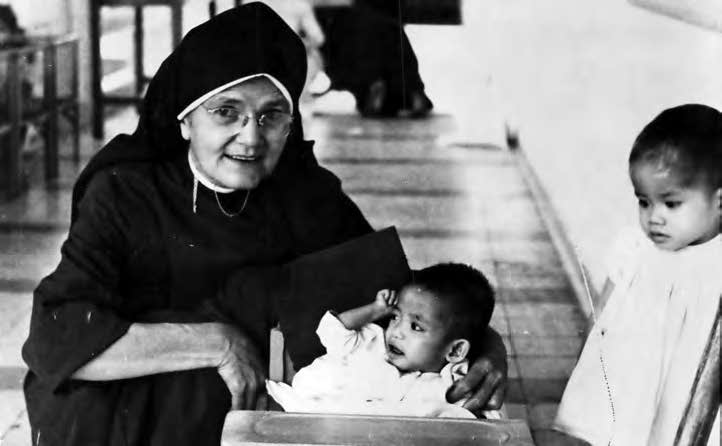
run by Catholic Relief Services in Saigon in 1968. (Photo: Courtesy of Maryknoll)
PROSPECT HEIGHTS — Catholics served with distinction during the U.S. military involvement in the Vietnam War, but not all carried weapons or even served in uniform.
Religious sisters from many communities labored to ease the suffering of innocent people caught in the crossfire, as did many priests.
These ministries faced peril. Viet Cong guerillas, for example, often hit targets away from the major fighting — places where hospitals and orphanages risked collateral damage.
Maryknoll Sister Moira Riehl of Union City, New Jersey, who previously served many years in China, described the danger she saw in 1968 while serving at a Catholic Relief Services orphanage in Saigon.
“For several days, we were able to go to the camps and care for the injured and the sick people, but now that seems out of the question,” she said in a letter. “It seems sisters will be sought out by the Viet Cong if we try to do good to the people. This is the same story that we met years ago in China.”
The Department of Veterans Affairs reports that 11,000 women, most of them military nurses, served in Vietnam. Eight servicewomen died there, as did 59 civilian women working as government employees or aid workers.
None of the casualties were religious sisters. Still, their ministries continued during the U.S. military’s involvement in Vietnam, which ceased 50 years ago on March 29, 1973. The experiences of Sister Moira, two other nuns, and a priest, all from the Maryknoll Society, give insight into serving in a combat zone.
Sister Moira Riehl
When not helping children at the CRS orphanage, Sister Moira handed out relief supplies to adults and comforted widows. But the orphans especially needed the warmth of human love, so she arranged for the local high school girls to come each day to pick up and hold the babies.
Sister Moira said orphans between the ages of 8 months and 1 year old “cannot sit up, crawl, or hold their heads up, the result of malnutrition and lack of attention. So you see, there is much to be done.”
Sister Moira also described “many evident signs of God’s protection.
“Just the other day, as we entered the camp, gunfire started outside the gate,” she said. “One member of our staff left the office, and the M.P. would not let him on the street. He had to go to a nearby hotel.
“The Viet Cong entered every house in his neighborhood that night.”
Before Sister Moira left Vietnam in 1969, the Catholic Church made her a Dame of the Order of the Knights of the Holy Sepulchre. She died in 1991 at age 84.
Sister Marie Crowley
Sister Marie Crowley of Tewksbury, Massachusetts, was a registered nurse who had worked many years at a hospital in Pusan, South Korea.
She joined Sister Moira on a temporary assignment with CRS in Saigon.
Sister Marie was part of a medical team with four other nuns from different communities who tried to reach the city of Hue in 1968, but the fighting was too intense.
According to a report sent to Maryknoll, “the sisters had to return to the center in Saigon. Then Saigon came under siege.
“The five sisters in their apartment all crowded into a closet to take shelter from gunfire. A nearby U.S. Army M.P. rushed in and got them down flat on the floor, where there was less likelihood of being hit by bullets. The sisters survived and got back to their work.”
Sister Marie died in January. She was 95.
Sister Virginia Farrell
A native of Bridgeport, Connecticut, Sister Virginia had already worked various nursing jobs before she became a U.S. Army nurse in 1952.
She served in the Korean War and was awarded the Bronze Star. Also, in Korea, she met the Maryknoll Sisters while volunteering at their Pusan hospital. She subsequently made her vows and joined the community.
In 1968 Sister Virginia agreed to be “on loan” to a medical team in Vietnam sponsored by the U.S. Catholic Conference. Based in Nha Trang, she became its field director, training Vietnamese nurses in rural hospitals.
A year later, she transferred to Saigon, where she searched the streets for unaccompanied, malnourished children and brought them to an orphanage for food and medical care.
Sister “Ginnie” described the work in a Christmas letter to the community. She said that the countryside and beaches rivaled the beauty of the Hawaiian Islands. Still, the fighting was inescapable, with a steady soundtrack of thumping artillery rounds and, at night, the eerie glow of illumination flares.
“Believe me,” she wrote, “it’s the oddest sensation to stand on the balcony of your home and ‘watch’ the war take place. I can’t describe the way I felt the day I flew over a Navy destroyer and watched the puffs of smoke and fire belching forth as it shelled the countryside.”
Sister Ginnie was 94 when she died in 2020.
Father Paul Duchesne
“Our man in Saigon” is how Maryknoll Magazine described Father Paul Duchesne, a missioner from Cohoes, New York, who also worked in Indonesia and Taiwan.
In a letter dated May 21, 1964, Father Patrick O’Connor, a Columban priest, described Father Duchesne’s work in Vietnam.
“His activities went far beyond mere distribution of surplus foods,” Father O’Connor wrote. “He promoted and took a close, continuing interest in constructive projects, from building hospitals to hog-raising; the rehabilitation hospital for polio victims; new houses for fire victims; the new hospital completed in Kontum, another planned for Dalat; buildings and food-producing projects for the Ben San Leprosarium; engines for fishermen’s boats. … These are just some of the developments he promoted and helped to direct.”
Father Duchesne was 72 when he died in 1983 in Hong Kong.

The Good News, like the Gospel of Our Lord and Savior, Jesus Christ.